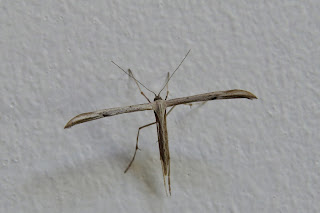Common plume - Emmelina monodactyla
It seems to be my week for finding plume moths. As I was mowing the lawn this weekend, this chap kept on flying ahead of the mower. It turned out to be a Common plume. Although "Common" I still think that it is a beautiful moth. No necessarily marked with any major contrasting features, but the subtly of the markings are still intriguing in their own right.
Emmelina
monodactyla LINNAEUS, 1758
Superfamily - PTEROPHOROIDEA
Family - PTEROPHORIDAE
It has a couple of alternative common names along with Common Plume, it is also known as the T Moth and Morning Glory Plume Moth. The habit of rolling up its wings at rest in the T shape is reflected in it's latin name which describes the wing shape very clearly when the moth is at rest as its appears to only have one (mono) finger (dactyl) although this is because the lightly coloured brown wing is highly rolled up and there are actually more fingers with thin feathery hairs which look much like the wings of a bird.
It has a worldwide distribution: Europe : Africa : Asia : North America : Mexico.
Like most of the Pterophoridae, the wings are cleft or divided but this can be difficult to see as the moth often rests with the wings rolled up tightly (1). The wing colour is usually pale brownish, but can be darker. Each pair of spurs on the hind legs has one spur longer than the other. The abdomen has a pale buff dorsal longitudinal band with brown streaks along the midline.
It occurs in any suitable habitat where the larval foodplants occur, which Fred on bind weed and convolvulus. Larvae have also been reported occasionally on Morning Glory and Oraches. They feed in two overlapping generations on leaves and flowers from late May to September.
The adults occur in all months of the year, and occur in overlapping generations, which can hibernate as adults over winter. It is one of the commonest of the 'Plume' moths all over Britain. In the Butterfly Conservation’s Microlepidoptera Report 2011 this species was classified as common.
Superfamily - PTEROPHOROIDEA
Family - PTEROPHORIDAE
It has a couple of alternative common names along with Common Plume, it is also known as the T Moth and Morning Glory Plume Moth. The habit of rolling up its wings at rest in the T shape is reflected in it's latin name which describes the wing shape very clearly when the moth is at rest as its appears to only have one (mono) finger (dactyl) although this is because the lightly coloured brown wing is highly rolled up and there are actually more fingers with thin feathery hairs which look much like the wings of a bird.
It has a worldwide distribution: Europe : Africa : Asia : North America : Mexico.
Like most of the Pterophoridae, the wings are cleft or divided but this can be difficult to see as the moth often rests with the wings rolled up tightly (1). The wing colour is usually pale brownish, but can be darker. Each pair of spurs on the hind legs has one spur longer than the other. The abdomen has a pale buff dorsal longitudinal band with brown streaks along the midline.
It occurs in any suitable habitat where the larval foodplants occur, which Fred on bind weed and convolvulus. Larvae have also been reported occasionally on Morning Glory and Oraches. They feed in two overlapping generations on leaves and flowers from late May to September.
The adults occur in all months of the year, and occur in overlapping generations, which can hibernate as adults over winter. It is one of the commonest of the 'Plume' moths all over Britain. In the Butterfly Conservation’s Microlepidoptera Report 2011 this species was classified as common.




Comments
Post a Comment